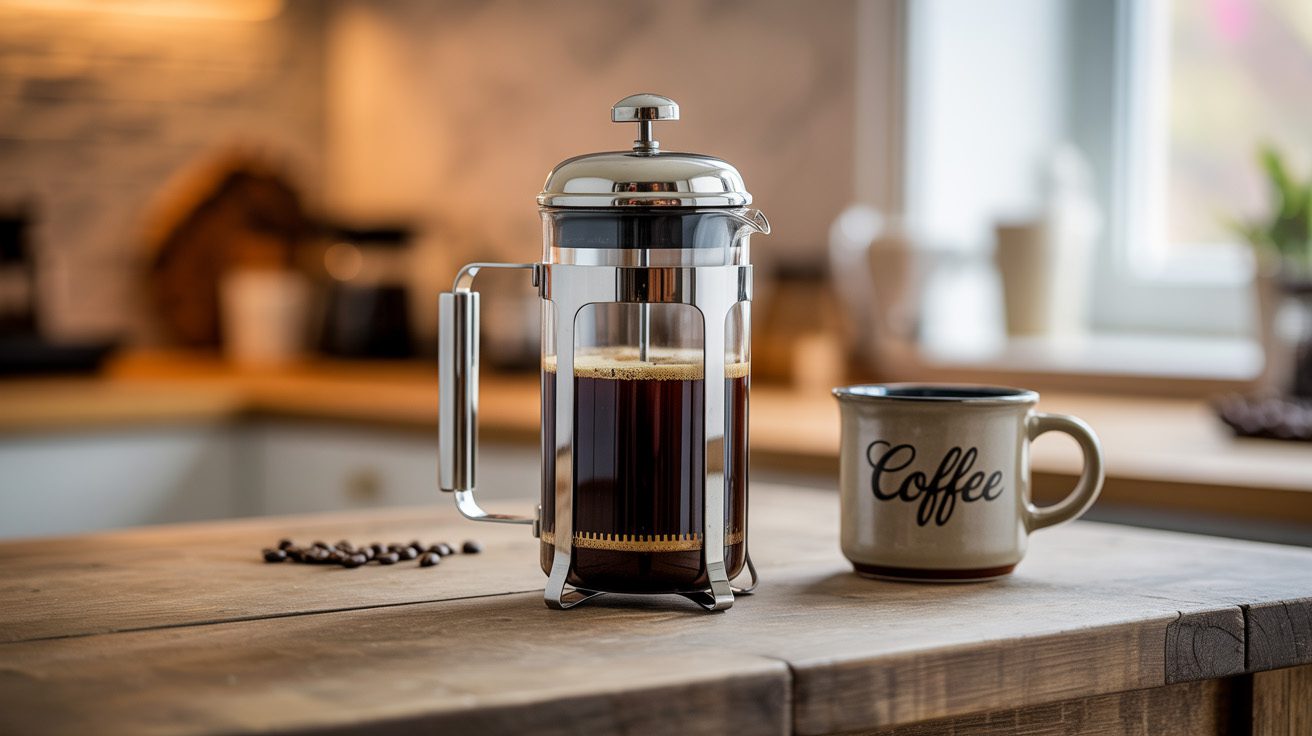Coffee Blog
The French Press: A Deep Dive into the Timeless Brewer in Your Cabinet

Tucked away in countless kitchen cabinets, often behind more complex and shiny machines, sits a humble cylinder of glass and metal. It is a device of elegant simplicity, requiring no electricity, no paper filters, and no advanced technical knowledge. This is the French press, known globally by many names: cafetière, press pot, or melior. Despite its unassuming appearance, it is one of the most immersive, full-bodied, and rewarding methods of brewing coffee ever invented.
To understand the French press is to appreciate a brewing philosophy that is fundamentally different from drip or espresso. It is a method of immersion and extraction, a full-immersion baptism of coffee grounds in hot water. This process, and the iconic device that makes it possible, has a rich history that belies its everyday presence. This is the story of the French press—where it came from, how it works, and why it remains an indispensable tool for coffee lovers worldwide.
What Exactly Is a French Press?
At its core, a French press is a simple brewing device. Most modern versions consist of three primary parts:
-
The Beaker: Typically a cylindrical glass carafe, though some are made of thermal stainless steel or ceramic. This is where the magic happens—where coffee grounds steep in hot water.
-
The Lid/Plunger Assembly: This is the defining mechanism. A lid fits snugly on top of the beaker, with a metal rod extending down through its center.
-
The Filter Plate: Attached to the end of the rod is a circular metal plate, surrounded by a fine mesh filter, usually made of stainless steel.
The process is beautifully straightforward: coarsely ground coffee is added to the beaker. Near-boiling water is poured over the grounds, saturating them completely. After a designated steeping time (usually 4-5 minutes), the user slowly presses the plunger down. The mesh filter plate moves through the brew, pushing all the spent coffee grounds to the very bottom of the beaker and trapping them there. What remains above the filter is a clean, rich, and incredibly flavorful cup of coffee, ready to be poured and enjoyed.
The result is a unique sensory experience. Because a metal mesh filter is used instead of a paper one, the natural oils and fine solubles from the coffee bean (known as fines) are not absorbed or blocked. They pass freely into the brew, creating a coffee with unparalleled body, texture, and a complex, robust flavor profile. It’s a cup that feels heavy and luxurious on the tongue, often described as “chewy,” and it delivers the true, unvarnished essence of the coffee bean.
The Murky History: An Invention with Many Fathers
The history of the French press is a tale of incremental innovation, patent filings, and European ingenuity, with its origins often hotly debated. While it feels quintessentially French, its story begins in Italy.
The earliest known patent for a device resembling a French press was filed not by a Frenchman, but by two Italian gentlemen: Attilio Calimani and Giulio Moneta in 1929. Their design featured the core principles we recognize today: a pot, a plunger, and a filter. However, their invention was likely a refinement of earlier, cruder designs that used a cloth or mesh screen pushed through a pot—a method that had been used in various forms across France and Italy for decades prior.
The story then shifts to France. In the 1950s, a man named Faliero Bondanini developed a similar device. He began manufacturing it in a French clarinet factory under the brand name “Melior.” The Melior pot, often made of chic chrome and heat-resistant glass, became a sensation in French cafés and homes. Its design was slightly different from the Italian patent, often featuring a distinct, rounded beaker shape. The success of the Melior pot is likely why the device became permanently associated with France and earned the name “French press” in English-speaking countries.
Across the channel, the British were also making their mark. In 1958, a British company called Household Articles Ltd. filed a patent for a “Coffee Maker” by one William Frank Summer. The design was strikingly similar to the modern French press, and the patent was eventually acquired by the Danish design giant Bodum. Under Bodum’s marketing prowess and sleek Scandinavian design, the “Chambord” model became the archetypal French press for a generation of coffee drinkers in the 1980s and 1990s, cementing its place in kitchens across Europe and North America.
So, who truly invented it? The answer is that it was a collective effort. The Italian patent laid the groundwork, the French “Melior” popularized it and gave it a name, and Danish design and British patents globalized it. It is a truly European invention.
Why Brew with a French Press? The Merits of Immersion
In an age of single-serve pods and super-automatic machines, the French press endures for powerful reasons:
-
Unfiltered Flavor and Body: The metal filter is the star. By allowing coffee’s natural oils and micro-fines to pass into the cup, it produces a brew with a texture and depth that paper-filtered coffee simply cannot match. This is the preferred method for those who love a robust, “full-bodied” coffee.
-
Total Control: The French press puts you in the driver’s seat. You control the water temperature, the coffee-to-water ratio, the grind size, and, most importantly, the steep time. This makes it an excellent tool for learning about coffee extraction and tailoring your brew to your exact taste preferences.
-
Simplicity and Sustainability: There are no electricity cords, no moving parts to break, and no ongoing cost of paper filters. It is a one-time purchase that, if cared for, can last a lifetime. This makes it both an eco-friendly and economical choice.
-
Versatility: Beyond coffee, a French press is a surprisingly multi-functional kitchen tool. It’s excellent for whipping cream, frothing milk (by pumping the plunger rapidly), brewing loose-leaf tea, making cold brew concentrate, and even straining broth or rinsing quinoa.
Mastering the Press: A Step-by-Step Guide to the Perfect Brew
Using a French press is simple, but mastering it requires attention to a few key details.
What You’ll Need:
-
French press
-
Burr grinder (crucial!)
-
Gooseneck kettle (ideal, but not mandatory)
-
Scale (for precision)
-
Fresh, high-quality coffee beans
-
Timer
The Process:
-
Heat Your Water: Bring fresh, filtered water to a boil (around 200°F or 93°C). Using filtered water without impurities or strong mineral tastes will ensure a cleaner coffee flavor.
-
Weigh and Grind: Weigh out your coffee beans. A standard starting ratio is 1:15—so 30 grams of coffee for 450 grams (ml) of water. This is the most critical step: grind your coffee coarsely. It should have a texture similar to coarse sea salt. A fine grind will slip through the mesh filter, creating a muddy, over-extracted, and gritty cup.
-
Pre-heat & Add Coffee: Pour a little hot water into the empty press to warm it up, then discard it. Add your coarsely ground coffee to the dry, pre-heated beaker.
-
Bloom: Start your timer and pour just enough water (about twice the weight of the coffee) to saturate all the grounds. Give it a gentle stir with a spoon to ensure no dry pockets remain. Let it sit for 30 seconds. This allows the coffee to “bloom”—releasing CO2 gas—which leads to a more even extraction.
-
Pour and Steep: After the bloom, slowly pour the remaining water. Place the lid on top with the plunger pulled all the way up. Let the coffee steep for 4 minutes.
-
Press: After 4 minutes, it’s time to press. Place your hand firmly on the lid and gently press the plunger straight down. Do not force it. If you meet strong resistance, your grind is likely too fine. The press should be slow and steady, taking about 20-30 seconds.
-
Serve Immediately: Pour your coffee into your cup or a separate carafe immediately. Do not let it sit in the press with the grounds. The grounds will continue to extract and stew at the bottom, making your coffee bitter. This is the number one mistake people make.
A Timeless Tool for the Modern Age
The French press is more than just a coffee maker; it is a testament to the idea that the best things are often the simplest. It connects us to a century of coffee tradition, offering a pure, unadulterated, and hands-on brewing experience. It demands our participation and rewards our patience.
In a world that often values speed and convenience above all else, the four-minute ritual of the French press is a welcome pause. It is a moment to slow down, to engage with the process, and to anticipate the rich, rewarding cup that is the product of your own effort. It is a timeless classic, and it isn’t going anywhere.



 Bee Mugs
Bee Mugs Bird Mugs
Bird Mugs Bunny Mugs
Bunny Mugs Cat Mugs
Cat Mugs Goat Mugs
Goat Mugs Horse Mugs
Horse Mugs Lion Mugs
Lion Mugs Monkey Mugs
Monkey Mugs Moose Mugs
Moose Mugs Owl Mugs
Owl Mugs Sheep Mugs
Sheep Mugs Snail Mugs
Snail Mugs Turtle Mugs
Turtle Mugs Unicorn Mugs
Unicorn Mugs
 Engagement Mugs
Engagement Mugs Retirement Mugs
Retirement Mugs St Patrick’s Day Mugs
St Patrick’s Day Mugs Thank You Mugs
Thank You Mugs
 Boss Mugs
Boss Mugs Christmas Mugs
Christmas Mugs Colleague Mugs
Colleague Mugs Dad Mugs
Dad Mugs Grandad Mugs
Grandad Mugs Grandma Mugs
Grandma Mugs Husband Mugs
Husband Mugs Lawyer Mugs
Lawyer Mugs Nurse Mugs
Nurse Mugs Sarcastic Mugs
Sarcastic Mugs Uncle Mugs
Uncle Mugs Wife Mugs
Wife Mugs
 Fourth of July Mugs
Fourth of July Mugs Halloween Mugs
Halloween Mugs Thanksgiving Mugs
Thanksgiving Mugs Valentines Day Mugs
Valentines Day Mugs
 Amsterdam Mugs
Amsterdam Mugs Barcelona Mugs
Barcelona Mugs Berlin Mugs
Berlin Mugs Chicago Mugs
Chicago Mugs Dubai Mugs
Dubai Mugs London Mugs
London Mugs Paris Mugs
Paris Mugs Rome Mugs
Rome Mugs Sydney Mugs
Sydney Mugs Tokyo Mugs
Tokyo Mugs Toronto Mugs
Toronto Mugs
 Aunt Mugs
Aunt Mugs Boss Mugs
Boss Mugs Boyfriend Mugs
Boyfriend Mugs Co-Worker Mugs
Co-Worker Mugs Couples Mugs
Couples Mugs Gamer Mugs
Gamer Mugs Girlfriend Mugs
Girlfriend Mugs Nanny Mugs
Nanny Mugs Sister Mugs
Sister Mugs Teachers Mug
Teachers Mug
 Baseball Mugs
Baseball Mugs Fishing Mugs
Fishing Mugs Football Mugs
Football Mugs Golf Mugs
Golf Mugs Rugby Mugs
Rugby Mugs Soccer Mugs
Soccer Mugs Tennis Mugs
Tennis Mugs
 Best Man Mugs
Best Man Mugs Bridesmaids Mugs
Bridesmaids Mugs Father of the Bride Mugs
Father of the Bride Mugs Groomsmen Mugs
Groomsmen Mugs Matron of Honor Mugs
Matron of Honor Mugs
 Inspirational Mugs
Inspirational Mugs Offensive Mugs
Offensive Mugs Sexy Mugs
Sexy Mugs